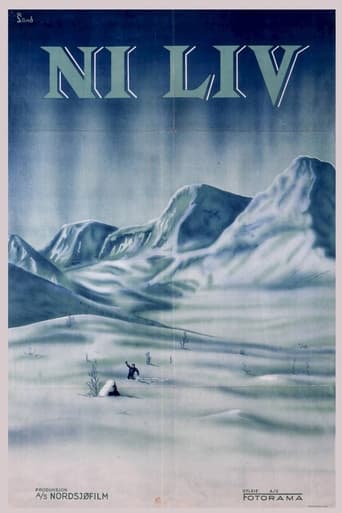MARIO GAUCI
The first two Best Foreign Language Film Oscars ever awarded were both won by Italy, through Federico Fellini, for LA STRADA (1954; awarded in 1956) and NIGHTS OF CABIRIA (1957); the other nominees competing against the latter emanated from France (Rene' Clair's GATES OF Paris), two I plan on catching up with presently (from India, Mehboob's MOTHER India and, from Germany, Robert Siodmak's THE DEVIL STRIKES AT NIGHT) and, from Norway, the film under review. Incredibly enough, Ingmar Bergman's art-house phenomenon THE SEVENTH SEAL was unsuccessfully submitted for Oscar consideration! Incidentally, NINE LIVES was also entered in that year's Cannes Film Festival where it rubbed shoulders with (among others) Mikhail Kalatazov's eventual Palme D'Or winner THE CRANES ARE FLYING, Jacques Tati's MON ONCLE (1958) and prestigious Hollywood fare like THE BROTHERS KARAMAZOV (1958) and THE LONG HOT SUMMER (1958).While the film's title and heritage might suggest a historical chronicle of some tragic national expedition, the story actually deals with a real-life WWII manhunt for a Norwegian spy – engaged with the English forces on an obscure sabotage mission of which he is the only survivor – on his way to sanctuary in neutral Sweden. The film starts with the dispatching of Jan Baalsrud's ten comrades-in-arms during a skirmish with a German patrol boat. Soon enough, our protagonist is on the run from the Nazis while facing the harsh natural elements of the Norwegian snowscape. Despite the inherent danger to themselves, the local communities (especially a young family and an elderly schoolteacher) he comes in contact with all go out of their way to help the heroic fugitive. In fact, the title is a specific reference to Baalsrud's feline-like penchant for survival against all odds: going snowblind; hacking off his own frostbitten toes; being literally entombed in snow for several weeks, etc. For the most part, the treatment is pretty matter-of-fact (and no less effective for that) with the only stylistic flourishes on display being the intermittent fast cutting whenever impending danger ensues, the repeated panning suggesting the upward direction of the flight and a striking ellipsis that goes from a man picking up the receiver to 'rat' on the hero and his comrades to a ship's cannon firing at their boat; however, there is also some confusion here as well: they are shown being shot at as they reach land – presumably in a flashforward – followed by them still out at sea! For the record, this might well be the first Norwegian film I have watched and, as far as I know, the only other one I own is the intriguing horror film LAKE OF THE DEAD (1958)...
Tom Erik Høiås
The very best there is. When you absolutely, positively got to see a great survival movie, accept no substitutes. I've seen this movie 4 times. i never grow weary of it, because to this day it still entertains the hell out of me. the superb direction and supreme thrills made this movie stand the test of time. 50 years since it's release, it has a strong following of fans that love this movie for all that its worth. i would be heartbroken if i didn't have this movie in my DVD collection! every movie collector should have this, because it is really one of a kind! Jack Fjeldstad portrays Jan Baalsrud in a truly great fashion. The movie was nominated for an Oscar in 1958, but lost to "Notti di Cabiria, Le" (1957). i haven't seen it. but to win over "Ni Liv", it has to be great!
dbdumonteil
...no beast could have done it! (Antoine de Saint-Exupéry, Guillaumet's words ,in "les Camarades") This famous sentence was on my mind all along the movie, which I had never heard of before and which was a big surprise for me.Once again,thanks to my good IMDb pal,Oystein ,who provided me with one fine work from his native country.I will try and introduce it to my French cinebuffs friends cause it is virtually unfairly unknown over here.A resistant fighter ,during WW2,stays in an hospital.He seems seriously wounded.He remembers :the film will consist of a very long flashback.After all his companions have been killed or captured ,the hero begins a long odyssey to get to the Sweden border.Little by little,we realize that the enemy is no longer the Nazis who occupy his homeland :it's the white spaces,the frozen fjords ,the cold,the wolves ,a hostile nature .The film is so intense that we often "feel "the hero's sufferings.Remarkable sequences:the hallucinations,the hero sees a woman ,then a neon reading "GRAND HOTEL" while he is lost in a white hell;all these humble people who risk their life for their compatriot,particularly the woman and her baby and the good old grandpa;the "resurrection " when Jan rose from the snow,like a Nordic Lazarus;the final rein deers stampede .This is really a splendid effort from Norway.
pjapproved
Ni Liv is based on a true story. We follow Jan Baalsrud on his dramatic escape from the Germans after a sabotage-mission. Being the only survivor, he has to flee across the Norwegian mountains to Sweden. He encounters different people and hard weather conditions during his incredible journey.Director Arne Skouen has created a unique experience of a film. It is a celebration of the human spirit and a tale of incredible courage. The visual style of the film is at a level never seen in Norwegian film before (or after). Jack Fjellstad also delivers a great performance in the leading role. The traces of on stage acting, witch is common in Norwegian film, are completely erased.In short. This is a highly imaginative and wonderful film not to be missed.My rating :***1/2 out of ****.


